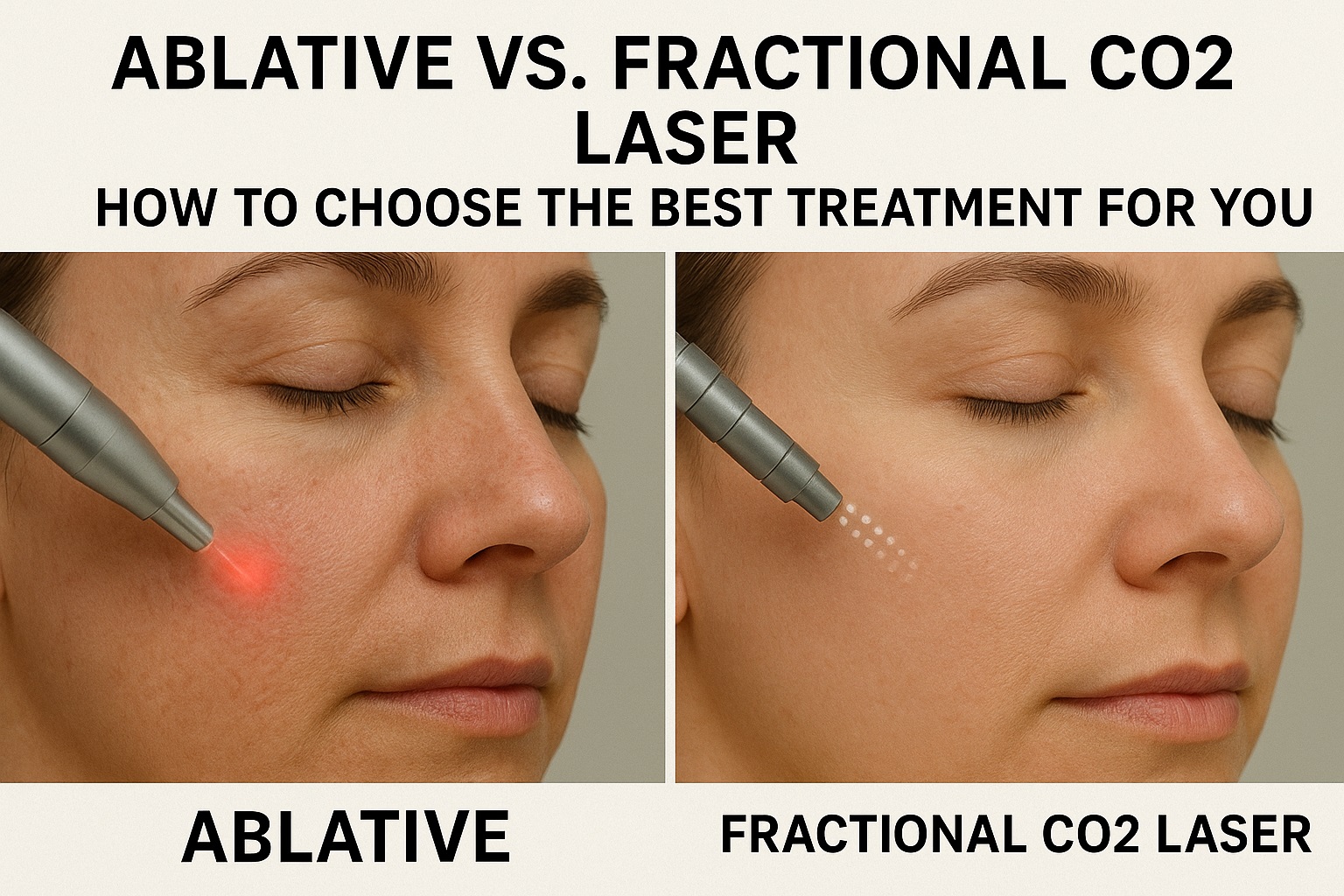As you consider laser resurfacing, you’re looking for a solution that truly works. The CO2 laser is a powerful and proven tool for a wide range of skin issues. It’s an effective option for treating acne scars and other texture problems. People often ask, “What is the difference?” It’s a great question because understanding the distinction is key to a successful treatment. We’ll explore the science behind each method, compare their benefits, and help you make a confident decision.
Understanding the Ablative CO2 Laser
The ablative CO2 laser is the original form of laser resurfacing. Think of it as a full-surface treatment. It works by precisely and fully vaporizing the entire outer layer of your skin. This is a very aggressive procedure that completely removes damaged tissue. When the top layer is removed, your body initiates a robust and powerful healing response. The skin rebuilds itself from the ground up, producing vast amounts of new collagen. This new collagen smooths out imperfections and restores a youthful texture. For individuals with deep wrinkles or severe acne scars, the dramatic results from one session are often life-changing.
Pros of Ablative CO2 Laser
-
Dramatic Results: A single treatment can lead to profound improvements in deep wrinkles, severe sun damage, and significant acne scars.
-
One-Session Efficacy: You often need just one session to achieve your desired outcome, saving time and money in the long run. (Read more about one-session treatments here)
-
Collagen Induction: This treatment creates a powerful thermal injury, which triggers a very strong collagen remodeling response that continues for months.
-
Versatility: In addition to scars, it can also address precancerous lesions, deep-set wrinkles, and significant textural irregularities. (Learn about other clinic services)
Cons of Ablative CO2 Laser
-
Significant Downtime: The recovery period is much longer, typically lasting 2 to 4 weeks. Your skin will ooze, crust, and be very sensitive during this time.
-
Higher Risk: There is an increased risk of complications, including infection, prolonged redness, and hyperpigmentation, especially in individuals with darker skin tones. The American Academy of Dermatology provides more detail on this.
-
Discomfort: The procedure is more uncomfortable and often requires local anesthesia or even sedation for the patient to be comfortable. The ASDS offers insights on pain management.
-
Post-Care Intensive: You must follow a strict and meticulous post-care routine to prevent complications and ensure proper healing.
Understanding the Fractional CO2 Laser
A fractional CO2 laser represents a more modern and refined approach to skin resurfacing. This technology is a true innovation. Instead of treating the entire skin surface, it delivers laser energy in a fractionated pattern, creating thousands of microscopic treatment zones. The device leaves the surrounding tissue untouched. These untouched “islands” of healthy skin are crucial because they act as a reservoir for rapid healing. The body heals faster since it only has to repair small, controlled areas of damage. This method offers a great balance between effective results and manageable downtime, which is why the fractional laser has become so popular.
Pros of Fractional CO2 Laser
-
Reduced Downtime: Recovery is significantly shorter, typically lasting just 5 to 7 days. Most people can return to their normal routine relatively quickly. Just like with hair transplant recovery, a quick return to normal life is a huge benefit.
-
Lower Risk of Complications: By leaving a significant portion of skin untreated, the risk of hyperpigmentation and other side effects is substantially reduced. This makes it safer for a broader range of skin types. A study on fractional laser efficacy confirms its safety profile.
-
Customizable: Your doctor can easily adjust the settings to tailor the treatment to your specific concerns and skin type. This is a huge benefit for personalized care. (Personalized treatment is key in many medical fields.)
-
Excellent Results: While it may require multiple sessions, the overall results are impressive. Patients achieve significant improvement in skin texture, firmness, and tone.
Cons of Fractional CO2 Laser
-
Multiple Sessions: You often need a series of sessions (usually 3 to 5) to achieve the same results as a single ablative treatment. This increases the total cost and time commitment. Explore clinics that offer packages for multiple sessions.
-
Less Aggressive: It is not as effective for very deep wrinkles or severely pitted scars as the ablative version. Sometimes, the more intensive approach is needed.
-
Ongoing Cost: The total cost can be higher than a single ablative session due to the need for multiple appointments. However, the cumulative effect is often worth it. (Compare costs across different medical treatments.)
-
Less Dramatic Initial Change: While improvements are noticeable, they are more gradual than the significant transformation seen after a single ablative procedure.
Patient Journey: The Story of Maria
To understand the real-world impact of choosing between these two treatments, let’s look at a hypothetical case study. Maria, a 45-year-old marketing executive, had deep-set wrinkles and noticeable sun damage from years of beach vacations. She also had some minor scarring from a childhood accident. Because of her busy professional life, she couldn’t afford a long period of downtime. She was a prime candidate for the more modern fractional approach.
During her consultation, her doctor explained that a single, intensive ablative treatment would give her dramatic results but would sideline her for a full two weeks. Instead, they recommended a series of three fractional treatments. Each session would require only a long weekend for her recovery. After her first session, she saw her wrinkles soften and her skin tone become more even. With each subsequent session, the results accumulated. A year later, her skin was noticeably smoother, firmer, and more youthful. She got the results she wanted without having to interrupt her life. This case highlights how a fractional laser can be a superior choice for those with a demanding schedule.
Conversely, consider David, a retired man with very deep, pitted acne scars. He was not concerned about downtime and wanted the most significant results possible. He chose an ablative laser treatment. His recovery was difficult and required several weeks of careful aftercare. Nevertheless, his patience was rewarded. His scars, which had bothered him for decades, were dramatically reduced. The single-session efficacy of the ablative laser was perfect for his needs.
Ablative vs. Fractional CO2 Laser: A Quick Comparison
Choosing between an ablative vs. fractional CO2 laser is a decision you should make with a qualified professional. To help you visualize the differences, here is a quick comparison table. It offers a side-by-side look at the key factors you should consider.
| Feature | Ablative CO2 Laser | Fractional CO2 Laser |
|---|---|---|
| Treatment Approach | Removes the entire top layer of skin. | Creates microscopic columns of injury, leaving healthy skin intact. |
| Downtime | Significant (2-4 weeks). | Minimal (5-7 days). |
| Effectiveness | Excellent for deep scars and wrinkles. | Excellent for moderate scars and fine lines. |
| Number of Sessions | Typically a single treatment. | Requires multiple sessions (3-5). |
| Safety for Dark Skin | Higher risk of complications. | Safer; lower risk of hyperpigmentation. |
| Cost per Session | Higher. | Lower. |
Who is This For? Finding Your Perfect Match
Your ideal treatment depends on your specific goals, lifestyle, and skin type. Knowing who a treatment is for is often more important than just understanding the procedure.
You might be a candidate for an Ablative CO2 Laser if:
-
You have deep, pitted acne scars that have resisted other forms of treatment. Find a clinic specializing in advanced scar treatment.
-
You are treating severe sun damage or very deep facial wrinkles. Consult with a top-rated plastic surgeon or dermatologist.
-
You can afford the necessary downtime for a complete recovery.
-
You prefer a single, powerful session over a series of treatments. (Discuss single-session options with an expert.)
You might be a candidate for a Fractional CO2 Laser if:
-
You have moderate acne scars, fine lines, or uneven skin texture. (This clinic specializes in aesthetic treatments.)
-
You have a demanding schedule and need a shorter recovery period. (They offer a wide range of quick-recovery procedures.)
-
You have a darker skin tone and want to minimize the risk of pigmentation changes. (Find a clinic with experience treating all skin types.)
-
You are comfortable with a series of treatments to achieve your final result.
FAQ: All Your Questions Answered
The choice between an ablative vs. fractional CO2 laser is a common one. Here are the answers to the most important questions you might have. We’ve compiled them to help you feel confident and informed.
1. How does the CO2 laser actually work?
The CO2 laser works by delivering a specific wavelength of light energy that is highly absorbed by the water content in your skin. This process causes a controlled thermal injury, either by vaporizing the top skin layer (ablative) or by creating tiny micro-channels (fractional). This injury stimulates the body’s natural healing response and massive new collagen production.
2. Is the treatment painful?
The pain level varies between the two. Ablative procedures are more intense and typically require a nerve block or sedation. Fractional treatments are generally less painful and can be managed with a strong topical numbing cream and a cooling device during the procedure. Pain management is key in all medical procedures.
3. What is the typical downtime for each?
Downtime is a major differentiator. Ablative laser downtime is usually 2 to 4 weeks, with the most intensive healing in the first week. Fractional laser downtime is much shorter, around 5 to 7 days, with most of the peeling and redness subsiding quickly. (The Mayo Clinic provides an overview of recovery.)
4. When will I see results?
For ablative lasers, you will see a dramatic initial improvement after the skin heals in a few weeks, with full results emerging over several months. With fractional lasers, the results are more gradual, with noticeable changes after each session and the final outcome visible about 3 to 6 months after your last treatment.
5. How long do the results last?
The results from both treatments are permanent. The new collagen your body produces is your own, and it won’t disappear. However, the natural aging process and sun exposure will still affect your skin over time. Proper skincare and sun protection are essential for maintenance. Similar to hair transplants, long-term results depend on care.
6. Can I use makeup after the procedure?
You must avoid makeup on the treated area for at least a week after a fractional treatment and longer after an ablative one. Your doctor will provide specific instructions, but generally, you must wait until the skin is fully re-epithelialized to prevent infection.
7. Which is better for acne scars?
For deep, pitted acne scars (like boxcar and ice pick), the ablative laser is often considered the gold standard due to its aggressive approach. For more moderate scarring or a combination of scars and fine lines, a fractional laser is an excellent choice. Find a specialist who can examine your scars.
8. What is the biggest advantage of the fractional method?
The most significant advantage of the fractional method is the dramatically reduced downtime. This makes the treatment accessible to people who cannot take an extended break from work or social activities. It’s a huge benefit for busy individuals.
9. Is the risk of side effects different?
Yes, the risks are different. The ablative approach carries a higher risk of complications like prolonged redness, infection, and especially hyperpigmentation. The fractional approach has a lower risk profile due to the preservation of healthy skin. This is why it is considered safer for a wider range of skin tones. Medical risks and benefits are always important to weigh.
10. Can these treatments be used on the body?
Yes, both can be used on the body, but are most commonly used on the face. Ablative lasers are sometimes used for body scars, but the fractional method is often preferred for areas like the neck, chest, and hands because the skin on these areas is thinner and more delicate. Surrogacy and other treatments can also be tailored to individual needs.
11. How do I prepare for my treatment?
Preparation is key. You should avoid sun exposure for at least four weeks before your appointment. Your doctor might also recommend a specific skincare regimen or prescribe an antiviral medication to prevent a cold sore outbreak. Preparation is a crucial step for many procedures.
12. How much do these procedures cost?
The cost of these procedures varies significantly based on location, the doctor’s experience, and the size of the area being treated. Ablative lasers are often more expensive per session, but you may only need one. Fractional lasers are less expensive per session, but the total cost can be comparable if you need multiple sessions. Contact a clinic for a detailed pricing breakdown.
13. Can a fractional laser be as good as an ablative?
For certain conditions, yes. For fine lines, minor scars, and texture issues, multiple sessions of fractional laser can achieve results very similar to a single ablative treatment. The best option depends entirely on the specific problem you are trying to solve and your ability to manage downtime.
14. Is it a good idea to combine them?
It’s not common to combine them in one session, but doctors will often use a combination of treatments. For instance, they might use an ablative laser on a very deep scar and a fractional laser on the surrounding area. This is a topic to discuss with your dermatologist. (Doctors can combine techniques for best results.)
15. What are the signs of a successful treatment?
After the initial healing, you will notice smoother skin texture, a reduction in the depth of scars and wrinkles, and a more even skin tone. These improvements will continue as your body produces new collagen over the next several months. See our clinic directory for experienced doctors.
16. What is the difference between CO2 and Erbium lasers?
CO2 lasers are typically more powerful and penetrate deeper. They are the gold standard for deep wrinkles and scars. Erbium lasers are gentler and more suitable for superficial lines and light sun damage, with less downtime. Find a clinic that offers a variety of laser treatments.
17. How can I ensure I get the best results?
To get the best results, always choose a board-certified dermatologist with extensive experience in laser resurfacing. Follow their pre- and post-treatment instructions meticulously, and protect your skin from sun exposure. The NCBI provides a great overview of laser therapy.
18. What is the cost difference between ablative vs. fractional CO2 laser?
On a per-session basis, a fractional laser is typically more affordable. However, since you may need multiple sessions, the total investment might be similar to a single ablative treatment. A consultation is the best way to get an accurate estimate. Medical tourism costs vary greatly by procedure and location.
19. Can I treat my neck and chest?
Yes, but with caution. The skin on the neck and chest is thinner and heals more slowly than facial skin. A fractional laser is typically the preferred method for these areas to minimize the risk of complications. Your doctor will create a specific plan for these more sensitive regions.
20. Is the ablative vs. fractional CO2 laser choice about budget?
While cost is a factor, the decision should primarily be based on your skin concerns, the severity of the problem, and your tolerance for downtime. Choosing a treatment that is not right for your skin type or lifestyle can lead to frustration and suboptimal results. Financial considerations are part of a comprehensive treatment plan.
Final Thoughts: Your Journey to Smoother Skin
The choice between an ablative vs. fractional CO2 laser is a personal one. Both offer a powerful path to skin rejuvenation, but they take different routes. Your dermatologist can help you navigate this decision and choose the path that aligns with your skin’s needs and your life’s demands. The key is to find a treatment that works for you, not against you.
Your skin is a reflection of your health, and treating it with the care it deserves is an investment in your well-being. By understanding the differences between these treatments, you are taking the first step towards a confident and beautiful future.
Schedule Your Consultation with wmedtour.com for the Best Results




